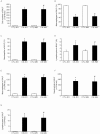Comparison and evaluation of two different methods to establish the cigarette smoke exposure mouse model of COPD
- PMID: 29133824
- PMCID: PMC5684336
- DOI: 10.1038/s41598-017-15685-y
Comparison and evaluation of two different methods to establish the cigarette smoke exposure mouse model of COPD
Abstract
Animal model of cigarette smoke (CS) -induced chronic obstructive pulmonary disease (COPD) is the primary testing methodology for drug therapies and studies on pathogenic mechanisms of disease. However, researchers have rarely run simultaneous or side-by-side tests of whole-body and nose-only CS exposure in building their mouse models of COPD. We compared and evaluated these two different methods of CS exposure, plus airway Lipopolysaccharides (LPS) inhalation, in building our COPD mouse model. Compared with the control group, CS exposed mice showed significant increased inspiratory resistance, functional residual capacity, right ventricular hypertrophy index, and total cell count in BALF. Moreover, histological staining exhibited goblet cell hyperplasia, lung inflammation, thickening of smooth muscle layer on bronchia, and lung angiogenesis in both methods of CS exposure. Our data indicated that a viable mouse model of COPD can be established by combining the results from whole-body CS exposure, nose-only CS exposure, and airway LPS inhalation testing. However, in our study, we also found that, given the same amount of particulate intake, changes in right ventricular pressure and intimal thickening of pulmonary small artery are a little more serious in nose-only CS exposure method than changes in the whole-body CS exposure method.
Conflict of interest statement
The authors declare that they have no competing interests.
Figures









References
-
- Global strategy for the diagnosis, management, and prevention of chronic obstructive pulmonary disease January 2015; Available from: http://www.goldcopd.org (Updated 2015).
Publication types
MeSH terms
Substances
LinkOut - more resources
Full Text Sources
Other Literature Sources
Medical

